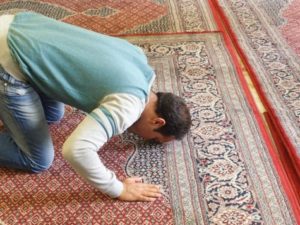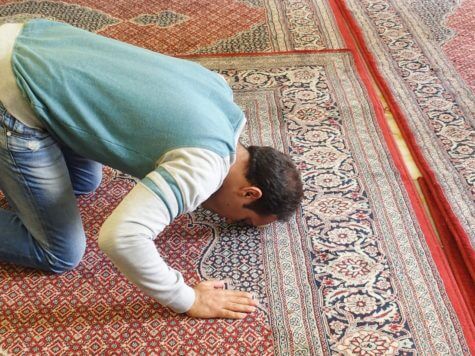BINGHAMTON, N.Y. — Prayer and other religious practices have long been linked to spiritual benefits, but the intricate and almost yoga-like qualities of the Islamic prayer ritual — the Salat — may also have a direct physical advantage for those with back pain, a recent study finds.
Muslims across the world bow, kneel and place their foreheads on the ground as part of the prayer ritual adhered to in following the five mandatory pillars of Islam set forth by the religion’s holy book, the Qur’an. A trio of researchers from Binghamton University, part of the State University of New York system, conducted a study that connects the complex physical motions of the five daily prayers to a reduction in lower back problems.
“One way to think about the movements is that they are similar to those of yoga or physical therapy intervention exercises used to treat low back pain,” says professor Mohammad Khasawneh, who is also the Systems Science and Industrial Engineering Department Chair at the university, in a press release.

The study found that when conducted properly, the bowing portion is the most stressful on the lower back, but for those with pain in this area, the use of the correct knee and back angles during the ritual can decrease pain.
The researchers warn that performing incorrect angles and movements can have the adverse effect, actually worsening pain. They also noted that for some with more severe back pain the correct posturing and movements may not be possible.
The researchers compared data from computer-generated human models of healthy Indian, Asian and American men and women, alongside models with lower back pain.
“The kneeling posture (sujud) increases the elasticity of joints. It is recommended for these individuals to spend more time in the kneeling posture,” Khasawneh adds. “Prayer can eliminate physical stress and anxiety, while this research indicates prayer rituals can be considered an effective clinical treatment of neuro-musculoskeletal dysfunction.”
Although the study focused exclusively on Islamic prayer practices, the researchers note that similar actions are performed in Christian, Jewish and other religious ceremonial acts.
The study’s co-authors plan to validate the findings of this paper with physical experiments using sensors and cameras tracking the stresses on individual body parts used during the prayer rituals.
This research was described by the co-authors as “an ergonomic study of body motions during Muslim prayer using digital human modeling.”
The research was published in the latest issue of the International Journal of Industrial and Systems Engineering.

…And inspires them to kill infidels